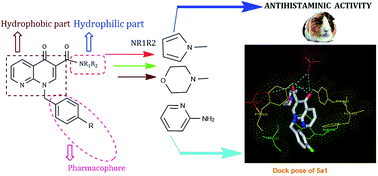Design, in silico studies, and synthesis of new 1,8-naphthyridine-3-carboxylic acid analogues and evaluation of their H1R antagonism effects†
Abstract
New 1,8-naphthyridine-3-carboxylic acid derivatives were designed, synthesized and evaluated for their in vivo antihistaminic activity on guinea pig trachea by using chlorpheniramine as the standard drug. It was found that compound 5a1 displayed a promising bronchorelaxant effect in conscious guinea pigs using the in vivo model. A molecular docking study was performed to understand the molecular interaction and binding mode of the compounds in the active site of the H1 receptor. Furthermore, in silico computational studies were also performed to predict the binding modes and pharmacokinetic parameters of these derivatives. Prior to the start of experimental lab work, PASS software was used to predict the biological activities of these compounds. An in silico PASS, Swiss ADME assisted docking approach was found to be suitable to derive and synthesize effective antihistaminic agents for the present study.

- This article is part of the themed collection: Molecular modelling


 Please wait while we load your content...
Please wait while we load your content...